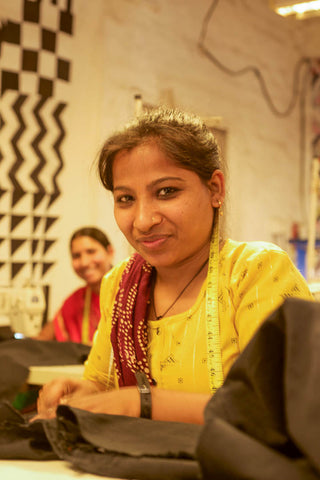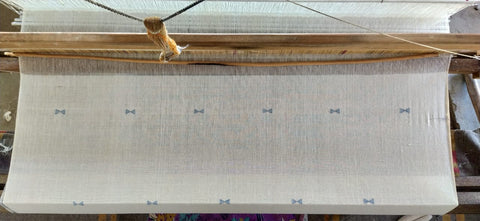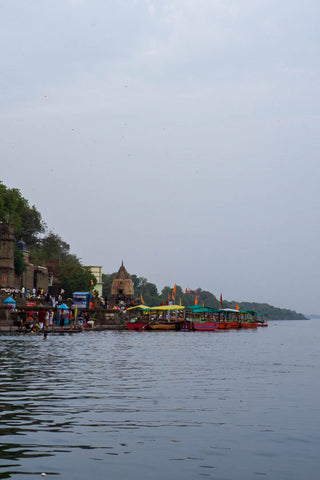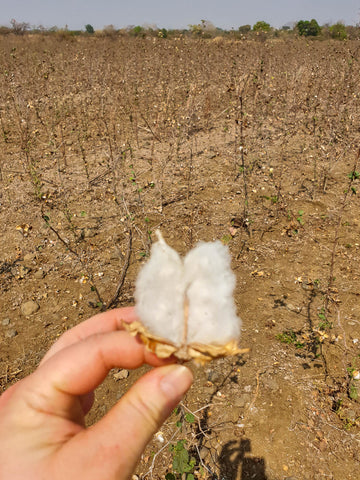Akshayan, age 6 sits with a weaver at a malkha weaving unit in telangana, August 2019
During March and April this year, I was finally able to travel to India for the first time since August 2019. We were lucky to have made the trip when we did in 2019, just before things closed down.
Until now, we've always travelled to India as a family. We value our kids getting the experience of understanding how clothing is made from start to finish, and would combine our sourcing trips with visits to our Indian relatives.
The meagre financial situation during the first years post-launch of a start-up (if only I'd known!), and the need to move quickly between cities and artisan locations to get work done (not so easy with kids in tow), made this trip the first where I travelled alone.
It was to be my fifth trip to India. I usually rely on Arindam to do the talking and coordinating - which makes sense, since he is the native Hindi/Bengali speaker. Although I had some worries, I generally did just fine on my own, and probably experienced things I wouldn't have, had we all been together. So in the end, although I love family travel - I would also opt for solo travel, although with small children, I am limited in how long I can go.

Akshayan, Avani and Arindam on the back of a motorcycle at the malkha natural dye unit outside hyderabad, August 2019. Me taking the picture to avoid getting on the bike.
With a few weeks notice in February, I had to decide which of our artisan partners to prioritize, due to the fact that with just over 3 weeks time at my disposal, I wouldn’t be able to visit everyone.
Regularly visiting the artisans and organizations who make our garments is vital; to develop relationships, to provide transparency to our community of customers, to understand the context in which our clothing is produced, to learn to work within that context with understanding and awareness, to ensure good health and safety standards in the varied workplaces, for design inspiration and collaboration, and to support innovation and development in our partner organizations.

Left to right: Indra, Vandana, Lata, Sapna and Renu of kullvi WHIMS, dyeing with marigold, April 2022
We launched our business in October 2021 with goods produced from just one organization, the women’s self help group Kullvi WHIMS in Himachal Pradesh, who make our woollens.
Beginning in early 2021, we've expanded to collaborating directly with seven new groups, and sourcing products from 3 more. We made these new connections remotely from Germany, some with people we'd visited during our 2018 and 2019 trips, and some we had never visited, until this trip! We still have a few on the list - and hope to get to those groups later this year.
Let’s take a look at where I went!

lakkarwala burj, sunder nursery, delhi, india, March 2022
I landed in Delhi on March 17th, a day before the festival of Holi, and took two days to acclimatize to the heat and time difference. I then travelled to Indore, in the state of Madhya Pradesh. This was the most important part of the trip, my first time meeting everyone at our manufacturing unit -- the talented people who are making our first clothing collection!
We had always meant to make clothes. Our woollens were meant to be the accessories! In fact, the whole idea for a business really started with a single dress design. The reason we launched with woolens first, is because we decided to circle back, dive deep and take the time to thoroughly research and develop our clothing collection by taking a design course, hiring a pattern maker and then have our fabrics custom dyed and woven.
After finishing the design process, earlier in 2021 I had gone down the list of manufacturers that I’d sussed out – and Kumbaya had come out on top. I reached out, and waited for a response.
We had lots of requirements on our list – but what really made Kumbaya stand out were a) they had a well established zero waste initiative in place – that means that they use off cut fabrics from the manufacturing process to produce items such as quilts and bags and even clothing, and b) they train and employ people with disabilities – this has always been something I have envisioned as an important focus of our business, particularly because of our family’s personal experience with having a child with special needs.

devka ji and Kamla ji, sewing at Kumbaya producer company stitching unit, zero waste quilt on the wall behind, march 2022
We had sent our paper sewing patterns to Kumbaya in the Fall, and had received our first sew samples back early this year, but had a lot of work to do together to finalize the patterns and then grade them into sizes, work on new patterns for next year (already!), confirm small but vital details like types of seams, labelling and embroidery, figure out how to work together across language barriers, and of course, just to get to know each other.

durgesh ji, master pattern maker, kumbaya producer company, madhya pradesh india, march 2022
I have been told I take risks.
I also have great luck.
Kumbaya did not disappoint – in fact it was a whole microcosmic macrocosm (is that even a thing?) of a world that I feel I was invited and ushered into, for some magical reason. Not only are their manufacturing skills excellent – stitching, design, sampling, etc. – all the important stuff, if you are designing a line of clothing – but we also shared something that made us click from the get go: self taught, motivated do-it-yourselfers that have learned by doing.
The organization holds this wonderful belief in people - that they can learn, regardless of their background – and this resonated with me – it’s what I grew up with, and know the best.
Want something? Figure it out.
It’s how I started this business.
I enjoyed every minute of my stay at Kumbaya, meeting so many people, both inspiring and inspired - and many thanks to Nivedita, who took me around to visit some of the amazing buildings that she has designed and built to house a multitude of remote rural agricultural, educational, and occupational initiatives and projects.

the sew samples for our first summer clothing collection, madhya pradesh, india, march 2022
After Kumbaya, I was taken on a beautiful drive through the back roads to stay in Maheshwar, a small town on the Narmada river that boasts, among other things, an ancient Fort, boat rides, and a thriving weaving community. Maheshwar is famous for Maheshwari saris, which were revived during the 70’s.

ahilya fort, maheshwar, Madhya Pradesh India, march 2022
If you walk down to the fort, you can hear the Rehwa Society looms clacking away, and walk in to see the work being done. Several weaving initiatives, including WomenWeave, Karghewale and Amba Weave have their offices, weaving and dyeing units around town, and a quick ride on the back of a motorcycle can take you around to each. I picked up a few shawls from WomenWeave for our summer markets, checked out the incredible luxurious shawls and skilled weavers at Amba, and then went to visit Sourodip from our weaving partners at Karghewale.

indigenous kala cotton with indigo motif - one of the fabrics being woven by Karghewale weavers for our first collection. kutch, gujarat, early 2022
We partnered with them to produce our kala cotton garments and shawls for this summer. Kala cotton is a rainfed old world cotton from the Kutch desert – we first visited Kutch in 2018, and had come to know about this indigenous breed of cotton, and were excited to work with it. It is farmed without pesticides and synthetic fertilizers. It will be really exciting to share these garments with you when they arrive!
They are all naturally dyed, spun and then woven in Kutch by young weavers who are graduates of the handloom school in Maheshwar. Karghewale specifically supports this new generation of young weavers in establishing their businesses. They work with around 150 weavers from many regions in India.

Ahilya Fort Ghats, maheshwar, Madhya Pradesh India, march 2022
After Maheshwar, I took a taxi back to Indore, and took a small plane to Nagpur, Maharashtra, another new place for me. I travelled to the town of Wardha, in the Vidarbha region of Maharashtra.
If you have heard about the large number of farmer suicides in India, the bulk of those suicides happened in this region. (If you have not heard about these suicides, I would suggest a bit of reading to understand the reason why it is so important for Rani & Reine to work towards a fully transparent supply chain, and why we should seek ways to support small scale cotton farmers in India – I have put a couple of book recommendations below, but a simple google search will bring up lots of information).
Wardha district is an important region for farming cotton, and the Gandhi Ashram in the nearby village of Sevagram makes it historically significant.

a harvested cotton field near Wardha, maharashtra, and an organic cotton boll. March 2022.
Each of the places we've visited deserves a full blog post! I hope you've enjoyed this first installment about our travels this year.
Stay tuned for part II - we'll be posting next week about our visit to Magan Khadi, in Wardha, Maharashtra, and the excitement of meeting with Kullvi WHIMS artisans again after such a long time. We also have some exciting news to share about our wool supply chain!

1 comment
Hi Sarah, Reading this post made me excited to see all the people, places and textiles in all forms of which you write. Your business is quite the journey! I have much respect for your vision, your dedication, artistry and skills